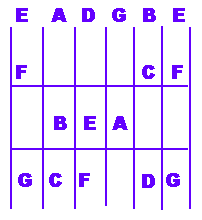
Section 1.4 Melody Notes & Creative Writing (back to index)
Three chords are all that you require !! They harmonise any of the seven notes from the major scale. Using tab we can prove this. Notes are played at different fundamental pitches on stringed instruments by altering the length of the string. Note the use of the term fundamental. Tones are usually made up of layers of sound. Musicians call these layers harmonic overtones. A scientist might refer to different frequencies of sound waves that occur overlapping each other. We as listeners then determine the pitch from the fundamental or dominant pitch in the layers.
In Western music we use a chromatic scale of twelve semi-tones. These semitones are set on the guitar strings by the fret spacing. If you hit an open string then finger the 12th fret of that string and play it, it SHOULD be an octave - use a tuner to check. Learn the sound of the octave if you are not already familiar with it - Now memorise the notes of the chromatic scale

Note that there are only seven note names (NB This is English UK Your country may use diff) .These are the first seven letters of the alphabet
A B C D E F G
After each note EXCEPT B and E the following note in the chromatic scale has two names. It is the SHARP of the note it follows and the FLAT of the note it precedes e.g. A# is also Bb Eb is also D# This is called enharmonic change. It is a lot easier to remember this instantly if you derive it - simply sharpen every note EXCEPT B and E and recall that these five notes have alternate names.
NOW and powerfully you can find any note on any string. You apply your new-found(perhaps) knowledge of the chromatic scale to the fret numbers of the guitar along with the names of the strings.
Use 1st position ruling ( 1st finger plays 1st fret, 2nd finger plays 2nd, 3rd finger plays 3rd 4th finger plays 4th fret) to try out the following examples Try these out -
Play E on the D string Play C on the A string Play A on the G string Play C on the B string Play F on the D string
so you should be playing E C A C F
Now try (1st position)
G on E String B on A string - but I'm sure you get the picture. Try calling random notes in Time and play them. Use different time values for differing note strings - eh! voila! - you are writing melody. A good tip here is to build up a picture of the guitar fretboard with only the natural notes so you get

These notes are the notes of the C Major scale. The chords of the C Major scale are derived from these notes according to the following rule of harmony - memorise this rule - build a chord on each note in this way - play a scale note, miss a note, play a note, miss a note, play a note. Example C Major = C E G. D minor = D F A etc. This gives us the following chord types
Major minor minor Major 7th minor diminished
these are always the same types for every major scale. Again this knowledge can be empowering NOTICE that once you know the notes in ANY major scale you can derive the chords of that scale from them. Here is the method for deriving a major scale from the chromatic. Choose the TONIC - the first note in the scale then apply the following rule
Tone Tone Semi-tone Tone Tone Tone Semi-tone
to the chromatic scale. So say we pick G as the tonic we get G A B C D E F# G as the scale and the chords are G Am Bm C D7 Em and F#dim.
So for C Major we get the chords C Dm Em F G7 Am Bdim (Note the convention of dropping the Maj suffix) However, you can get away with only using three of these chords. The first, fourth and fifth - written as I, IV, V by musicians and called either the I, IV, V *progression or the three chord trick.
(These Roman Numerals are pronounced as the English numbers one, four, five so it is pronounced ' the one four five progression ' . )
Here's some good news - E A and B7 are the three chord trick for E Major - so if you've been practising you already know this. Even more good news - if you click over to the Scots song section of busker.net there are many songs that fit the I IV V progression there and further instructions to help you to play them.